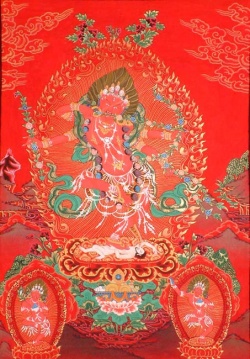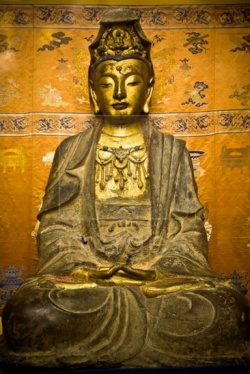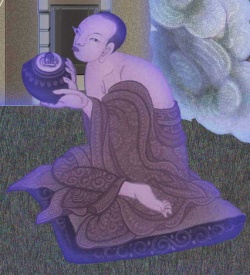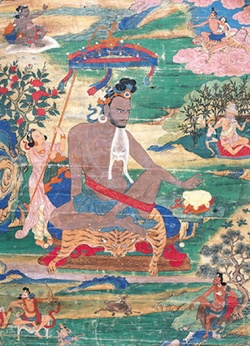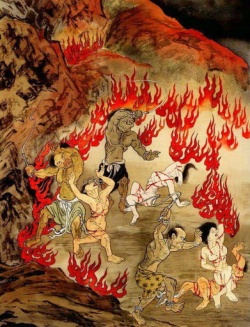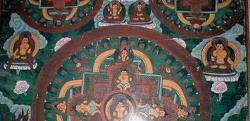Thodgyal
thod-rgal / Thodgal - passing over the summit (the development of vision practice in the Dzogchen Upadesha)
"The term Thodgal (thod rgal....Sanskrit: vyuthtkrantaka)...literally means "direct" (thod-rgal du) in the sense of an immediate and instantaneous transition from one location to another, where there is no intervening interval of time. Thus some would translate it as 'leap over'...but it is much more immediate than leaping about. Also, when we say 'vision' (snang-ha) we are not talking about visualization( (dmigs-pa) which, for example is used in Tantra. Visualization is a process which involves the working of the mind. However with Trkchod we have moved into a dimension beyond the mind and with Thodgal, one continues in this direction.
Rather than visualizations created by mind we are talking about an integration with vision, with whatever arises spontaneously to vision while the practiiioner is in the state of contemplation. Therefore, the master of contemplation through the practice of Thekchod is an immediate prerequisite to the practice of Thodgal...Otherwise there is the danger of becoming caught up in one's visions, becoming distracted by them and believing them to be an objective reality. It is precisely this attachment to one's impure karmic visions that got the individual caught up in samsara in the first place.......John Myrdhin Reynolds....'The Oral Traditions From Zhang-Zhung'....Page 33
Taught by Lopon Tenzin Namdak, .....Devon retreat, May 1991 .....
In the Dzogchen Upadesha teachings we have the practices of Thegchod and Thodgal. Thegchod means we enter into and continue in the state of contemplation (rig pa), the Natural State (gnas lugs). Thodgal means that while in the state of contemplation the potentiality of the Natural State (rig pa 1 rtsal) has the occasion to manifest spontaneously as vision. The medium for the manifesting of this potentiality is either sunlight total darkness or the open space of the sky.
The ultimate result of this Thodgal practice is the attaining of the Rainbow Body or Talu (ja lus).
Indeed Thodgal does possess a method for dissolving the impure physical body at the time of death or even before and then the Rainbow Body of Light manifests. But this is not a process of transforming an impure physical body into a pure Sambhogakaya. The method Proper to Dzogchen is not the path of transformation as is the case with the Tantras but the path of self liberation. So the procedure in Tantra and in Thodgal is quite different. To effect a transformation in vision and in energy Tantra employs visualization in terms of Kyerim and Dzogrim practice. We visualize ourselves in a Sambhogakaya form whether this be a peaceful or a wrathful manifestation.
But in Dzogchen there is nothing to be visualized and nothing to be transformed. The visions which arise during the course of Thodgal are not visualizations. Visualization represents the work of the mind; visualizations are created by the mind. But Dzogchen is a state beyond the mind. So these visions which arise in Thodgal are not created by the mind or by unconscious karma but they are a manifestation of what is already primordially present in the Natural State. The vision is not something created by causes but it is Lhundrub (Ihun grub) or spontaneously perfected. Since the Sambhogakaya is already fully inherent in the Natural State it simply manifests. Dzogchen alone discloses our real nature;
To realize the Rainbow Body means that we have practiced Thodgal and not some other method. The visions that arise are not specifically created but appear spontaneously (Ihun grub) in the presence of secondary causes such as sunlight, total darkness, and the clear open sky. They arise spontaneously from the Natural State; no Kyerim or Dzogrim practices must be done first as preparation. All that is required is the capacity to remain with stability in the Natural State. This is called stable Thegchod. Then the Thodgal visions come automatically whether in sunlight or total darkness or in the empty sky.
Gradually all the pure visions of the deities arise and these visions develop by way of four stages (snang ba bzhi) until completion. Then they all dissolve into the Natural State. Our personal reality of pure and impure vision (snang ba) dissolves into Reality (bon nyid) which is the Natural State. At the same time that our visions dissolve our physical body also dissolves because it is just one manifestation of our impure karmic vision. Our normal everyday impure vision has the same source as the Thodgal pure vision - and now both equally dissolve into their source the Natural State. There is a single Base, the Natural State, but there are two Paths - impure karmic vision and pure vision, and two Fruits or results - Samsara and Nirvana. Returning to the ultimate source then the potentiality of the Natural State manifests as a Rainbow Body, the real Rupakaya.
Excerpt from Golden Letters: The Three Statements of Garab Dorje
With regard to the Das-rjes, in each case the master in question attained the Body of Light at the time of his death, when he dissolved his physical body into the dimension of the space of the sky.
1. Tshig gsum gnad du brdreg-pa, "The Three statements That Strike the Essential Points, " of Prahevajra or Garab Dorje(dGa'-rad rdorje)
2. sGom nyams drug-pa,"The Six Meditation Experiences," of Manjushrimitra ('Jam dpal bshes-gnyen)
3. gZer-bu bdun-pa, "The Seven Important Points," of Shrisimha (dPal gyi seng-ge mgon-po)
4. bZhags-thabs bzhi, "The Four Methods for Remaining in Contemplation," of Jnanasutra (Ye-shes mdo)
From Tenzin Wangyal "This second part with its practices is very similar to the practice of Togal Even though it is not Togal it uses those methods. The means for stabilizing the mind in the experience is through the threefold training or three methods. Before you train the actual development of visions and experiences through the Dzogchen Togal practice you have to make absolutely sure that your pure awareness in the state of contemplation is a hundred per cent stable in the experience of Dzogchen Tregcho.
You know that you first have to stay in pure Dzogchen contemplation perfectly without any movements or any visions at all, then Togal will be effective in integrating experiences in this very state of pure awareness or non-dual contemplation. For this development or for the purpose of gaining stability in the contemplation there is a series of three practice methods and special circumstances to be applied consecutively. These methods are related and produce gradual development; first you train in the dark, then you gaze into the sky and finally you look at the sun.
Before one can practice Thodgal, one must first purify the twofold obscurations and master the state of contemplation throught Trekchod practice, a releasing or a cutting through of all one's tensions and rigidities. If one does not first perfect Thekchod as an absolutely necessary prerequisite, then the Thodgal practice will be little better than watching a cinema show. Although one practices Thodgal not in the state of ordinary consciousness but in the state of contemplation, there is nevertheless the ever-present danger that one will become attached to the visions that arise.
Excerpt from: The Golden Letters : The Three Statements of Garab Dorje, the First Teacher of Dzogchen, Together With a Commentary Garab Dorje, John Myrdhin Reynolds (Translator)
The Heart Drops of Dharmakaya teachings were composed by Shardza Tashi Gyaltsen, a Tibetan master who upon his death in 1935 achieved the rainbow body, in which his physical body dissolved into light. Shardza Rinpoche was one of the most influential Bon teachers of his time; his works are used as textbooks in many Tibetan monasteries.
Thod rgal meditation postures... the 3 postures (lion elephant, rishi) in Heart Drops of Dharmakaya. ... going with the Dzogchen Serzhün and the Bonpo Khandro Nyingthik....(Khandro Nyingtik (Wyl. mkha' 'gro snying thig) 'The Heart Essence of the Dakinis' — one of the 'Four Sections of Nyingtik' (Nyingtik Yabshyi). ...
The Khandro Nyingtik cycle itself consists of the Twelve ‘mother’ and ‘child’ Tantras of the Takdrol Gyü, the ‘Three Last Testaments of the Buddha’, and other teachings amounting to a total of sixty-five different categories. When the pith instructions are given according to the Khandro Nyingtik, it is these Twelve Tantras of the Takdrol Gyü and Three Last Testaments which are quoted as references
QUOTED TEXTS.....
The Oral Tradition from Zhang Zhung: An Introduction to the Bonpo Dzogchen Teachings of the Oral Tradition from Zhang Zhung known as the Zhang-zhung snyan rgyud
Translations, Commentaries, and Annotations by John Myrdhin Reynolds.
Forward by Lopon Tenzin Namdak
This impressive volume includes biographies of the principal early masters in the lineages of transmission of the Zhang-zhung snayn rgyud, translations of Guru Yoga and Dzogchen preliminary practices (ngondro) from the sNyan-brgyud rgyal-ba phyag-khrid. These explanations proceed according to the oral instructions of Yongdzin Rinpoche, Lopon Tenzin Namdak
Arrow and the Spindle: Studies in History, Myth, Rituals and Beliefs in Tibet
By Samten G. Karmay
Contains 32 articles written over the span of 20 years, covering aspects of history, Dzogchen philosophy, the Bon religion, myths and rituals including "The Soul and the Turquoise: a Ritual for Recalling the bla" and "The Local Deities and the Juniper Tree: a Ritual for Purification (bsang)", articles on the Gesar Epic, as well as on the reunification and disintegration of Tibet
Drung, Deu and Bon: Narrations, Symbolic Languages and the Bon Tradition in Ancient Tibet
By Namkhai Norbu, translated from Tibetan into Italian, and edited by Adriano Clemente,
translated from Italian into English by Andrew Lukianowicz Includes chapters on selected narrations, symbolic languages, and the twelve lores (sciences) of Bon
Heart Drops of Dharmakaya: Dzogchen Practice of the Bon Tradtion
By Shardza Tashi Gyaltsen, commentary by Lopon Tenzin Namdak
"This is one of the most important books in Dzogchen as demonstrated by the author, Shardza Tashi Gyaltsen, who attained the rainbow body. My kind root master, Lopon Rinpoche's clear and direct commentary elucidates all the major points of this essential text." --Geshe Tenzin Wangyal Rinpoche
Opening the Door to Bon
By Nyima Dakpa Rinpoche
Full of practical and explicit instructions, this handbook for Westerners details the outer and inner fundamental Bon practices.
Sacred Tibetan Teachings: On Death and Liberation
By Giacomella Orofino, preface by Namkhai Norbu Rinpoche
These are lightly used copies of the out-of-print and hard-to-find title. Included in these translations, there is one chapter entitled, "The Doctrine of the Six Lights," a translation of the Bonpo dzogchen text from the Zhang Zhung Nyen Gyu, The Oral Transmission of Zhang Zhung.
Unbounded Wholeness: Dzogchen, Bon and the Logic of the Nonconceptual
by Anne Carolyn Klein and Geshe Tenzin Wangyal Rinpoche
The long awaited study and translation of the "Authenticity of Open Awareness", a foundational text of the Bon Dzogchen tradition. It includes an extensive commentary and explanatory material.
Wonders of the Natural Mind: The Essence of Dzogchen in the Native Bon Tradition of Tibet
By Tenzin Wangyal Rinpoche, edited by Andrew Lukianowicz, with a foreword by H.H. the Dalai Lama
Introduction to Bon Dzogchen, based upon teachings of the Zhang Zhung Nyan Gyud, the Oral Transmission of Zhang Zhung.

